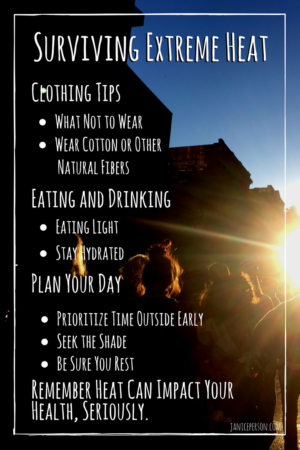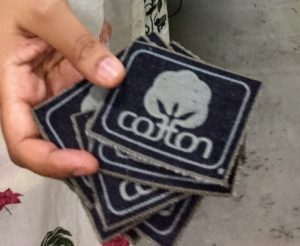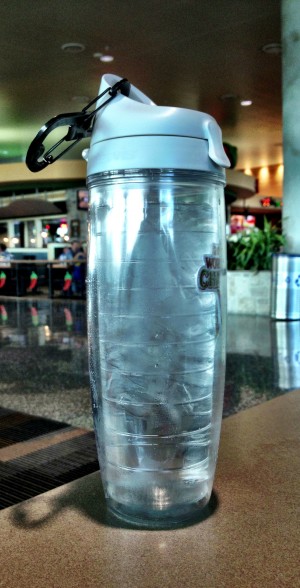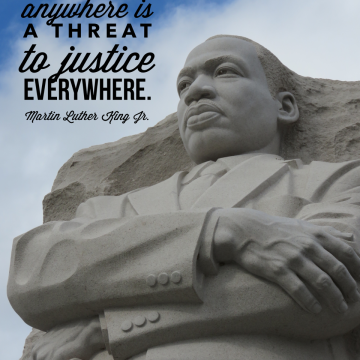Heat advisories are popping up all over the U.S. and the last week or two, my hometown of St. Louis has hit some temperatures and humidity levels that are staggering.
 Being outside for hours everyday is the norm for lots of people (some farmers, roofers, lawn care folks, etc.), but it is far from my normal day-to-day. On the other hand, I have lived down south most of my life and I realized I have internalized various things over the years that really qualify as survival or heat management tips that could be helpful to share. And besides, this post should be a great yin to the yang that is my post on surviving extreme cold!
Being outside for hours everyday is the norm for lots of people (some farmers, roofers, lawn care folks, etc.), but it is far from my normal day-to-day. On the other hand, I have lived down south most of my life and I realized I have internalized various things over the years that really qualify as survival or heat management tips that could be helpful to share. And besides, this post should be a great yin to the yang that is my post on surviving extreme cold!
Clothing Tips
What Not to Wear
It is easy to get in the habit of wearing the same thing, but as the temperature rises, you may want to consider what clothes you wear to work and just running errands, etc. Think about the colors and go lighter whenever possible, look at the tightness of the knit or the weight of the fabric and go light there as well. It is also helpful to wear things that loosely fit rather than are tighter as this provides increased ability for air movement. Even small things like unstarched shirts vs starched, khakis instead of jeans, a summer dress rather than slacks, etc… the little things add up and make a difference. In the what to wear category, my friend Ryan Goodman of Ag Proud points out the beauty of long sleeves for keeping the sun from beating down on you and hats can keep the sun off your neck too.
 Wear Cotton or Other Natural Fibers
Wear Cotton or Other Natural Fibers
On a blog written by JPlovesCOTTON, wearing cotton deserves its own subhead! I am a dedicated fan of wearing cotton most days but when it is extremely hot, I double-down on it. I also have some great linen pants, a silk dress or two. The difference is shocking. In fact the other day I pulled out a shirt and put it on, and immediately realized it wasn’t very breathable, looked at the tag and sure enough, it was a cotton-polyester blend. I found a 100 percent cotton shirt and the feel was different. (You can always learn more about my favorite crop in the cotton 101 series.)
Eating and Drinking
Eating Light
 It is easy to think you don’t want to eat when you are so hot, but that isn’t smart. You really need the energy that comes with protein, carbohydrates and more. Small light meals, especially something that can be served straight from the refrigerator are awesome. And even better if they don’t require too much baking or other efforts that heat up the kitchen anymore than you need. Making any kinds of salads (especially with some chicken, beef or other protein) or making wraps work well for me.
It is easy to think you don’t want to eat when you are so hot, but that isn’t smart. You really need the energy that comes with protein, carbohydrates and more. Small light meals, especially something that can be served straight from the refrigerator are awesome. And even better if they don’t require too much baking or other efforts that heat up the kitchen anymore than you need. Making any kinds of salads (especially with some chicken, beef or other protein) or making wraps work well for me.
Stay Hydrated
Drinking water is a mainstay for good health, and it is especially important with severe weather. And whether you love coffee, Cokes or something else, it is good to limit caffeine intake. Think about having decaf drinks you really like readily available is a key summer strategy for me. I tend to add in lemonade, sometimes Arnold Palmers, since reduces my caffeine and is still refreshing. I’ll confess, I still have Cokes now and then but I pay closer attention to the decision.
 Plan Your Day
Plan Your Day
Prioritize Time Outside Early
A friend who has Brahman cattle in South Texas definitely knows about the heat…. she said her family try to get as many of the outdoor chores they need to do out of the way early in the day before it heats up, or late in the day as it is cooling back down. That’s a good idea in the city too! Even small chores like taking the trash to the curb or pumping gas can make a girl sweat when it’s 100+ degrees outside. I’m willing to let my gas gauge go down til I can stop in the morning.
Seek the Shade
Whether it is walking between buildings or parking your car, thinking about shade is a good idea. The difference is so significant that you can feel it on your skin immediately. And it certainly makes a difference when you come back to the car, especially when you leave windows and the sunroof open a bit!
Be Sure You Rest
It is frequently easier said than done, but building rest into your days and weeks is important in extreme heat. The cumulative effects of the physical stress can make it hard on a body, especially for people who have chronic health issues.
Remember Heat Can Impact Your Health, Seriously.
Let’s start with putting this in context. Heat warnings are issued for a reason. Bad things can happen when you overdo in the heat. Heat cramps, heat stress and heat stroke are parts of the spectrum that you want to know the signs to watch for in yourself and others. The Mayo Clinic has a lot of resources on heat related illnesses, here’s an overview from the experts but I recommend you read up!
Heat cramps. Heat cramps, sometimes called exercise-associated muscle cramps, are painful muscle contractions that can occur with exercise. Affected muscles may feel firm to the touch. You may feel muscle pain or spasms. Your body temperature may be normal.
Heat syncope and exercise-associated collapse Heat syncope is a feeling of light-headedness or fainting caused by high temperatures, often occurring after standing for a long period of time, or standing quickly after sitting for a long period of time. Exercise-associated collapse is feeling light-headed or fainting immediately after exercising, and it can occur especially if you immediately stop running and stand after a race or a long run.
Heat exhaustion. With heat exhaustion, your body temperature rises as high as 104 F (40 C), and you may experience nausea, vomiting, weakness, headache, fainting, sweating and cold, clammy skin. If left untreated, heat exhaustion can lead to heatstroke.
Heatstroke. Heatstroke is a life-threatening emergency condition that occurs when your body temperature is greater than 104 F (40 C). Your skin may be dry from lack of sweat, or it may be moist. You may develop confusion, irritability, headache, heart rhythm problems, dizziness, fainting, nausea, vomiting, visual problems and fatigue. You need immediate medical attention to prevent brain damage, organ failure or even death.
Source: Heat and exercise: Keeping cool in hot weather – Mayo Clinic



Use the buddy system or text someone your location and expected plans if you are working or going to be outside alone…
That’s a great one! Also nice to check in on folks in general who are outside if you are inside.